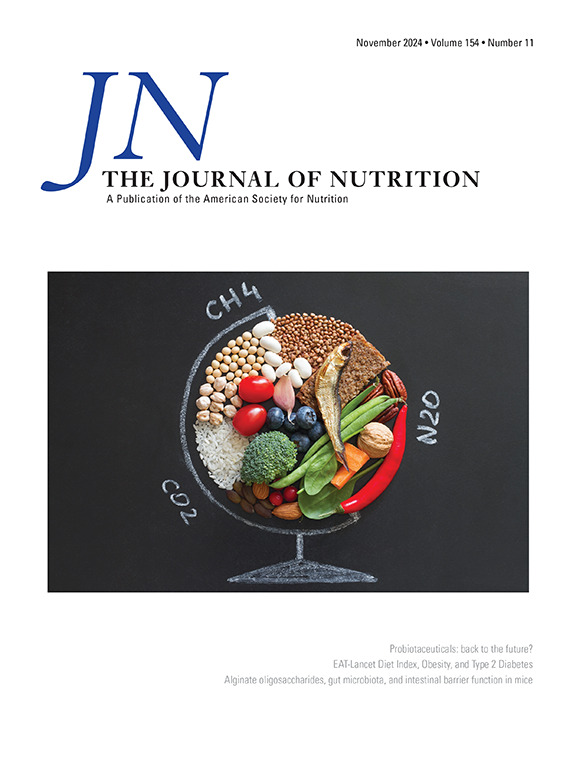Association Between Human Milk Oligosaccharides and Early Adiposity Rebound in Children: A Case–Control Study of the Tohoku Medical Megabank Project Birth and Three-Generation Cohort Study
IF 3.7
3区 医学
Q2 NUTRITION & DIETETICS
引用次数: 0
Abstract
Background
Adiposity rebound (AR) is the point when the BMI begins to rise again during early childhood. Early AR (before age 5) is associated with higher risk of lifelong obesity and metabolic disorders and may be influenced by breastfeeding. Although human milk oligosaccharides (HMOs) in breast milk are crucial for child growth, their association with AR status has not been studied.
Objectives
This study aimed to explore the association between breast milk HMOs and AR status in children.
Methods
In this case–control study, we included 184 mother–child pairs from the Tohoku Medical Megabank Project Birth and Three-Generation (TMM BirThree) Cohort Study (93 AR cases, 91 controls). Breast milk was collected 1 mo postpartum, and the concentration of 15 HMO molecules and α-diversity index (Inverse Simpson index) were quantified. Wilcoxon rank-sum test and partial least squares-discriminant analysis identified candidate HMOs, and multivariable logistic regression analysis evaluated associations between candidate HMOs and AR status. Analyses were stratified by maternal secretor status (secretor or nonsecretor).
Results
In secretor mothers, multivariable logistic regression showed that the inverse Simpson index [odds ratio (OR): 0.54; 95% CI: 0.36, 0.82), the sum of sialic acid–bound HMOs (OR: 0.61; 95% CI: 0.41, 0.91), and 3'-sialyllactose (OR: 0.67; 95% CI: 0.46, 0.98) were inversely associated with early AR in the fully adjusted model. A trend of interaction between sialyl-lacto-N-tetraose-a (LSTa) and maternal secretor status regarding AR was observed in the fully adjusted model (P-interaction = 0.051).
Conclusions
α-Diversity, sialic acid–bound HMOs, and 3'-sialyllactose may involved in inhibiting AR in children of secretor mothers, and a trend of interactive effect between LSTa and maternal secretor status regarding AR is indicated. These findings offer novel perspectives on the associations between breastfeeding and a childhood adiposity as well as potential metabolic disorders later in life.
This trial is registered at https://www.umin.ac.jp/ as UMIN000047160.
人乳低聚糖与儿童早期肥胖反弹的关系:东北医学大库项目出生和三代队列研究的病例对照研究
背景:肥胖反弹(adiobesity rebound, AR)是指儿童早期体重指数(body mass index, BMI)开始再次上升。早期AR(5岁前)与终生肥胖和代谢紊乱的高风险相关,并可能受到母乳喂养的影响。虽然母乳中的人乳寡糖(HMOs)对儿童生长至关重要,但它们与AR状态的关系尚未得到研究。目的:探讨儿童母乳中HMO成分及与AR状态相关的分子。方法:在本病例对照研究中,我们纳入了来自东北医学大库项目出生和三代(TMM BirThree)队列研究的184对母子(93例AR病例,91例对照)。产后1个月采集母乳,定量测定15种HMO分子浓度和α -多样性指数(逆辛普森指数)。Wilcoxon秩和检验和偏最小二乘判别分析(PLS-DA)确定候选HMOs,多变量logistic回归分析评估候选HMOs与AR状态之间的关系。根据产妇分泌状态(分泌或非分泌)对分析进行分层。结果:在分泌型母亲中,多变量logistic回归显示,在完全调整的模型中,逆辛普森指数(OR, 0.54 [95% CI, 0.36-0.82])、唾液酸结合HMOs总数(0.61[0.41-0.91])和3'-唾液乳糖(0.67[0.46-0.98])与早期AR呈负相关。在完全调整的模型中,观察到唾液-乳酸- n -四糖A (LSTa)与母体AR分泌状态的相互作用趋势(相互作用的p值= 0.051)。结论:α多样性、唾液酸结合HMOs和3sl可能参与抑制分泌型母亲的AR, LSTa与母亲分泌状态之间存在相互作用的趋势。这些发现为母乳喂养与儿童肥胖之间的关系以及以后生活中潜在的代谢紊乱提供了新的视角。注册号/网站:https://www.umin.ac.jp/(试验注册号:UMIN000047160)。
本文章由计算机程序翻译,如有差异,请以英文原文为准。
求助全文
约1分钟内获得全文
求助全文
来源期刊

Journal of Nutrition
医学-营养学
CiteScore
7.60
自引率
4.80%
发文量
260
审稿时长
39 days
期刊介绍:
The Journal of Nutrition (JN/J Nutr) publishes peer-reviewed original research papers covering all aspects of experimental nutrition in humans and other animal species; special articles such as reviews and biographies of prominent nutrition scientists; and issues, opinions, and commentaries on controversial issues in nutrition. Supplements are frequently published to provide extended discussion of topics of special interest.
 求助内容:
求助内容: 应助结果提醒方式:
应助结果提醒方式:


